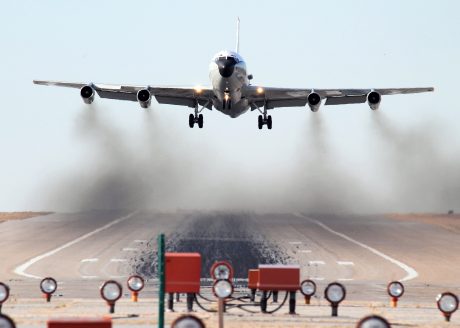While the world diplomatic community debates sanctions against North Korea following the reclusive nation’s underground nuclear test on Feb. 12, U.S. Air Force crews are in action over the Sea of Japan, searching for fallout from the explosion.
The WC-135 Constant Phoenix atmospheric collections aircraft is used to detect the radioactive particles that result from a nuclear detonation.
The WC-135 is a derivative of the Boeing C-135 transport and support aircraft. Ten of these aircraft have been operated since 1963, two of which remain in service today.
The aircraft are operated by flight crews from the 45th Reconnaissance Squadron from Offutt Air Force Base while mission crews are staffed by Detachment 1 from the Air Force Technical Applications Center.
The WC-135, known as the “sniffer” or “weather bird” by its crews, can carry up to 33 personnel. However, crew compliments are kept to a minimum during mission flights in order to lessen levels of radioactive exposure.
Effluent gasses are gathered by two scoops on the sides of the fuselage, which in turn trap fallout particles on filters. The mission crews have the ability to analyze the fallout residue in real time, helping to confirm the presence of nuclear fallout and possibly determine the characteristics of the warhead involved.

South Korean newspapers reported that WC-135 crews had been operating from
Kadena Air Base in Okinawa as early as Jan. 31, 2013 in anticipation of the most recent North Korean Test.
While the underground test likely utilized a series of tunnels, blast doors, and baffles to trap fallout, any radioactive particles that did escape will be useful to analyze the type of warhead and relative sophistication of the design and detonation mechanism.
The sophistication and size of the warhead help analysts determine whether North Korean nuclear technology is advanced enough to build a small warhead that can be delivered by missile.
SEE ALSO: The F-22's Most Important Feature Does Nothing To Help It Survive Aerial Combat
SEE ALSO: BI Military & Defense Facebook Page >
Please follow Military & Defense on Twitter and Facebook.